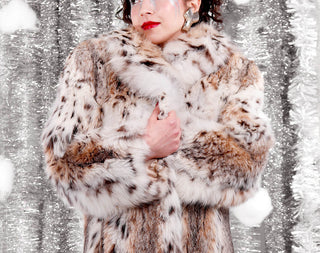Lisa and I always feel we need to add a disclaimer onto the listings of our vintage fur pieces. Fur is such a polarizing topic, and we are of the mindset that there are already enough vintage furs out there for everyone who would want one. We don't source a ton of fur, but every now and then we get a piece that we just cannot say no to! New fur and faux fur have their own major drawbacks, and these beautiful vintage fur coats and jackets are much better off getting a new life than going into a landfill.
Part of ensuring vintage fur pieces can be worn and re-worn year after year means properly storing and caring for your vintage fur. Today, we delve into the intricate art of caring for vintage fur, combining our deep knowledge of fashion history with a touch of learned expertise from working with vintage textiles for decades.
The Importance of Vintage Fur Care: In the realm of vintage fashion, caring for your fur pieces is more than a routine – it's an investment. The delicate nature of vintage fur requires special attention to maintain its beauty and value. Imagine each piece as a living artifact, and you'll understand why expert care is so important.
Expert Care Techniques: What sets us apart is not just the uniqueness of our pieces but the meticulous care that goes into each one. Our team, driven by a passion for preserving fashion history, employs expert cleaning, storing and mending processes. It's not just about restoring aesthetics; it's about honoring the craftsmanship that went into each piece.
Unique Challenges of Vintage Fur: Vintage fur comes with its own set of challenges – from matting to discoloration and fragility. Our expertise allows us to address these challenges head-on, ensuring that each fur piece retains its luster and allure. Regular care is not just a choice; it's a necessity to combat the effects of time.
Best Practices for Vintage Fur Storage
Preserving the longevity of your vintage fur is simple if you remember these easy steps:
The Rule of 50
Ideal conditions for fur storage are 50º at 50% humidity. 50º-60º F is the optimal storage temperature range, with humidity between 30% and 50%. Too much moisture and heat can cause mildew and other damage to the fur, and too little can cause drying out. We have clients who choose to store their furs in a storage facility, as many of these facilities keep the optimal temperature and humidity consistent for fur.
At home, a cool, dry closet can do the trick. A small portable thermometer with humidity sensor may come in handy, especially if you are considering storing fur in a basement or attic space.
Avoid the Sun
In order to preserve the original luxe color of your fur coat, direct sunlight should be avoided, especially in storage. Like hair lightening in the summertime, sunlight can fade darker black and brown furs rapidly. While lighter and white coats will not as obviously fade, they will start to take on a discolored yellowish hue.
Sun rays break down the keratin protective layer on fur, causing the discoloration and leading to the fur becoming dry, dull and brittle. Even more reasons to store your fur in a cool, dry, dark closet space with no exterior windows.
Have the Right Tools
The two things we always have on hand in the studio for our fur pieces are wide coat hangers and individual zippered canvas garment bags. These help your coat keep its shape, as well as protect it from sunlight and pests. While plastic is a great way to keep your fur from matting, canvas can provide the same protection without the added moisture and trapped heat issues that arise with plastic.
Breathing Room
We love the canvas garment bags because they allow garments to breathe. This is crucial for all textiles, especially natural textiles like silk, wool and fur. We also suggest giving your fur some space when storing it. Cramming it in with too many other hanging things limits air flow and can cause issues such as trapping heat and unsightly matting.
Keep it Clean
If you can, avoid spraying perfume or any scented spray directly onto your fur. Fur pieces are difficult to clean and tend to hold onto odors, so it is best to limit their exposure.
For off-season storage of any textile, including fur, we recommend having it professionally cleaned by a furier at the end of the season. This will get rid of any damage causing bacteria and odors, helping the eliminate issues before they occur.
Preserving the longevity of your vintage fur is an art in itself. When it comes to storage, think of your fur as a delicate treasure. Store it correctly, and you'll be rewarded with a fur piece that stands the test of time.

